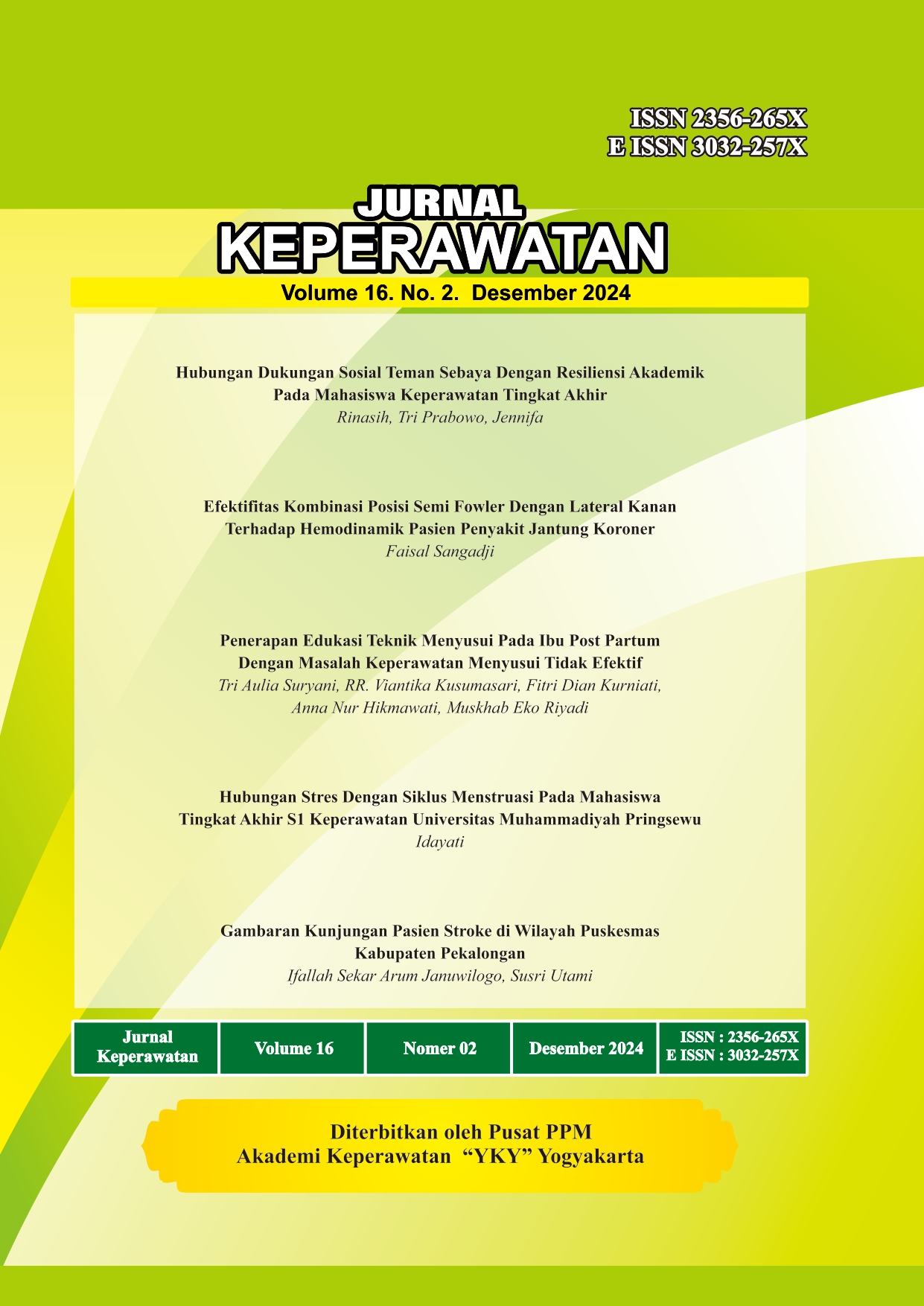PENERAPAN EDUKASI TEKNIK MENYUSUI PADA IBU POST PARTUM DENGAN MASALAH KEPERAWATAN MENYUSUI TIDAK EFEKTIF
DOI:
https://doi.org/10.61758/nursing.v16i2.180Keywords:
Edukasi, Post Partum, Teknik MenyusuiAbstract
Background: Post partum is a period when the lactation process is formed as a source of nutrition and a powerful defense against all forms of malnutrition in babies. One of the factors causing malnutrition in babies is low levels of exclusive breastfeeding. Low coverage is caused by breast milk production early in the breastfeeding period. Incorrect breastfeeding techniques will affect breast milk production and cause breast milk to not flow effectively from the mother's breast to the baby. Therefore, education on breastfeeding techniques is needed to increase breast milk production. Objective: This research is to determine the application of breastfeeding technique education to post partum mothers with ineffective breastfeeding problems. Methods: This type of research is a case study with research subjects consisting of 1 spontaneous primiparous post partum mother who experienced complaints of poor breast milk. Results : The implementation of breastfeeding technique education for post partum mothers with ineffective breastfeeding care can increase breast milk production as evidenced by the client reporting improved milk flow, increased confidence in breastfeeding, proper attachment of the baby to the breast, continuous sucking on the mother’s nipple, correct reastfeeding posture, and the baby appearing calm without crying. Conclusion: The application of educational innovation of breastfeeding techniques to postpartum mothers can overcome ineffective breastfeeding problems.
References
Aprilina. 2022. Keajaiban Menyusui. Malang: CV. Literasi Nusantara Abadi.
Artati, E., Putriningrum, R., & Widyastutik, D. 2023. Pengaruh Media Booklet Teknik Menyusui Yang Benar Terhadap peningkatan Keterampilan Menyusui Ibu Nifas Di Wilayah Kerja Puskesmas Cawas II. Repositori.https://eprints.ukh.ac.id/id/eprint/3858/
Dewi, A.P.S., Mutoharoh, S., Rahmadhani, W. 2021. Pendidikan Kesehatan Tentang Teknik Menyusui dengan Metode Peragaan dan Video. Indonesia Jurnal Kebidanan 5 (2).
Dinas Kesehatan Kabupaten Bantul. 2024. Buku Profil Daerah Kabupaten Bantul. Bantul.
Piesesha, F., Purnomo, W., Irawan, R. 2018. Maternal Parity and Onset of Lactation on Postpartum Mothers. Jurnal Humanistic Network for Science and Technology. 2(2), 212–220.
Himawarti, L.M.R. 2021. Pengaruh Pendidikan Kesehatan Tentang Teknik Menyusui Terhadap Pengetahuan Dan Perilaku Teknik Menyusui Pada Ibu Primipara Di Bps Kecamatan Kali Bawang Kulonprogo. Repository. https://digilib.unisayogya.ac.id/1630/
Kementrian Kesehatan Republik Indonesia. 2021. Profil Kesehatan Indonesia 2020. Jakarta.
Kementrian Kesehatan Republik Indonesia. 2024. Profil Kesehatan Indonesia 2023. Jakarta.
Masruroh, N., Rizki, L. K., Ashari, N. A., & Irma, I. 2022. Analisis Perilaku Ibu Menyusui dalam Memberikan ASI Eksklusif di masa Pandemi Covid 19 di Surabaya (Mix Method). Muhammadiyah Journal of Midwifery, 3(1), 1.
Nursalam. 2014. Pendidikan dalam Keperawatan. Jakarta: Salemba Medika.
PPNI (2017). Standar Diagnosis Keperawatan Indonesia: Defenisi dan Indikator Diagnostik. Edisi 1. Jakarta: DPP PPNI.
PPNI (2017). Standar Intervensi Keperawatan Indonesia : Defenisi dan Tindakan keperawatan, Edisi1. Jakarta : DPP PPNI
Rinata, E., Rusdyati, T., Sari, P.A. 2016. Tehnik Menyusui Posisi, Perlekatan, dan Keefektifan Menghisap: Studi Pada Ibu Menyusui Di Rsud Sidoarjo. Prosiding.https://jurnal.unimus.ac.id/index.php/psn12012010/article/view/2084
Supliyani, E. & Djamilus, F. 2021. Efektifitas Media Video Tutorial Penatalaksanaan Asi Ekslusif Terhadap Keterampilan Ibu Dalam Menyusui. Jurnal Riset Kesehatan Poltekkes Depkes Bandung, 13, pp.15-43.
Batjo, S.H., Longulo, J.O., Hehi, K., Rafika. 2021. Teknik Menyusui Melalui Video Meningkatkan Pengetahuan Ibu Hamil. Jurnal Media Kesehatan Politeknik Kesehatan Makassar, vol.XVI, no.1.
Zeiniyetus, S., Jeniawaty, S., & Alfiah, S. 2023. Pengaruh Edukasi Video Teknik Menyusui terhadap Produksi Asi pada Ibu Nifas di Puskesmas Kwanyar Bangkalan Madura. Journal of Midwifery Science and Women’s Health, 3(2), 58–62.









